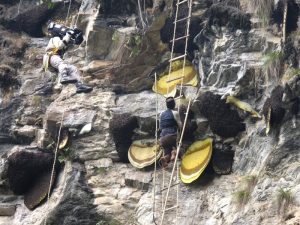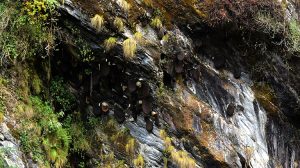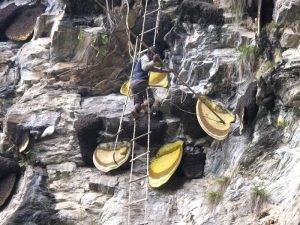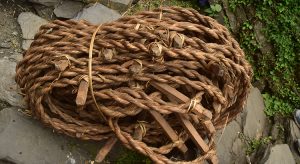Honey Hunting Filming in Nepal
No doubt being a mecca of mountain film destination, Nepal is still unexplored for wild filming destinations where so many natural stories are still hidden. One of them is tradition wild honey hunting filming in Nepal.
Filming in Nepal has organized couple of Honey Hunting Filming for foreign documentary. We did vast research of locations, method and select specific character for Honey Hunting Filming. As per our experience we will like to introduce some key elements for filming wild honey bees of Nepal!! In next blog we will come with the best filming destination and available character for Honey Hunting Filming with pictures.
Apis laboriosa honey hunting
There are about 5 different honey species are found in Nepal. Apis Laboriosa is one of the biggest honey bees which nested in the high cliff of the mountain. These bee species play a vital role in pollinating mountain crops and wild flora. Honey Hunting is a very ancient practice of mountain people specially Gurung, Rai, Chantyal Community. The main area of harvesting Honey Hunting is mountain region of Nepal like Kaski, Lamjung, Myagdi, Baglung, Rukum in western area of Nepal as as practices in the eastern belt of Nepal.
The red honey collected by Apislaboriosa bee during spring season from white rhododendron, Bikh (Aconitum spp.), Pangra (Entada scanders) and Niramasi are considered intoxicated. Intoxicating honey is not consumed locally while exporters benefit from the export of this honey due to its medicinal value and relaxing properties.
The Honey Hunting practices introduced in world by Eric Valli though his book “Honey Hunters of Nepal” The multiples film and documentary has made on Honey Hunting to give knowledge about traditional method as well as to show the adventure of Honey Hunting.
How do they do Honey Hunting?
Wild Honey Bees Harvesting can be done twice a year in May and end of September to early November. The village community can do only hunting in their own cliff they are not allowed outsiders to do hunting in their cliff. First, they will decide the honey hunting time by observing calendar from their priest or Shaman of the community. Tuesday is the best day for initiating honey-hunting event while Wednesday is not suitable for this event. Honey hunting is not allowed in 8th, 11th, 23rd, 26th and 30th day of moon cycle.
After the date decided by shaman, they start making parang (ladder for honey hunting) by collecting small bamboo from the forest along with other necessary equipment. There will be at least minimu 8 people necessary for harvesting – about 2 to 3 main honey hunter and rookie, 2 to 3 person for pulling rope and ladder, 1 main person to watch both sides Hunter and rope puller to co-ordinate between hunters and puller during harvesting and about 4 people to collect honey and making honey out of hives.
They will leave to the cliff by carrying all necessary equipment, food, shelter from the house where they have to stay at the cliff side min ¾ days for harvesting depends on the number of hives available in the cliff. They start harvesting honey after some ceremonial to worship god of the cliff. Mainly during worsip god they will sacrifice rooster to the god and start harvesting honey according to their rituals. In most of the area female are not allowed to go for harvesting Honey. As well as some communicate believe that they should not have sexual intercourse a night before leaving for Honey Hunting. If they do so it’s a bad luck for them and their god will get angry. In Myagdi, they do not sacrifice chicken as they believe their god do not accept sacrifice.
Equipment Necessary for Honey Hunting.
1 Prang (ladder) Made from bamboo fiber, 70 meters long (depending upon the height of cliff) and 2 cm in diameter. The steps are made of wooden planks
2 Uab (Rope) A kind of rope used for tightening the ladder to the tree trunk on the top of the cliff. It is made of bamboo fiber. Its length ranges from 5-10 meters depending upon the distance between tree trunk and the cliff
3 Pechho (Rope) It is also a kind of rope used for hanging bamboo basket. It is made of Allo (Girardia diversifolia) fiber. Its length ranges between 50 – 70 meters
4 Korko/Tokari (Bamboo basket) It is used for honey collection and is made of bamboo strips with the holding capacity of 20 liters
5 Chhyakal/Khaal (Basket lining) Earlier lamb’s skin was used in the basket to prevent honey from leakage but plastic sheets are being used these days
6 Tango/Ghochma (Stick) A bamboo stick fixed with a sickle or wooden plate at one end, which is used for cutting combs during honey hunting. It is about 7 meters long depending upon horizontal distance between nest and cliff end
7 Saaton (Stick) A bamboo stick similar to Tango but with notched end to fix the hook. It is also 7 meters long
8 Koili chho (Rope with hook) A rope fixed with hook and made of locally available fiber materials. It is around 14 meters long and used for separating the brood portion from honeycomb
9 Koho chho (Fastening belt) A rope used for fastening honey hunter to ladder for safety. It is made of local fiber materials
10 Chhora (Filter) It is made of bamboo cortex for filtering honey
11 Donga (Wax pot) It is made of wood and used for wax collection
12 Tuju (Rope) It’s a rope being used to balance ladder by tightening in different points and positions
13 Whibe (Rope) A rope made from bamboo fibers and used for manipulating ladder’s direction and positioning from the ground
14 Dabilo (Wooden knife) Wooden or iron knife fixed to the one end of bamboo stick used for cutting brood combs
Filming in Nepal has visited about 6 different location in Lamjung, 4 Locations in Kaski, 2 Locations in Myagdi and 1 Locations in Baglung. We have also collected the information of Estern Nepal. Where we found a family involved in Honey Hunting as their main occupation, Community involved in Honey Hunting and even a age of 17/18 yrs boy started harvesting honey hunting to continue their father works. So, do not forget to contact us for Honey Hunting filming in Nepal.






Leave a Reply